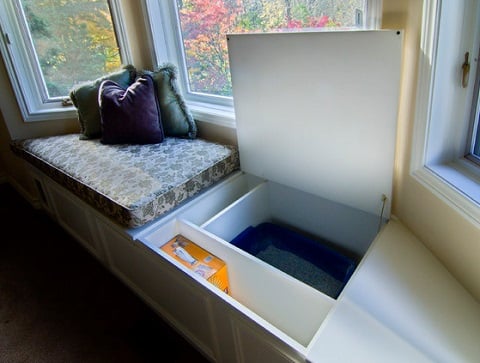If you own one or more cats, having a litter box is a necessary evil. They’re smelly, messy, and unpleasant, but a cat’s gotta do what a cat’s gotta do. That said, where you put your litter box can make a huge difference; a litter box that’s out of sight and out of mind is the next best thing to no litter box at all, just so long as it isn’t so well hidden your cat can’t find it. So if you’re looking for the best method and location for hiding your cat box, we’ve got a few sneaky ideas to get you started.
One of the most basic ways to conceal a litter box is to place it in a closed cabinet with a simple cutout opening in one of the doors (by Red River Remodelers, LLC, Alec Mccommon)The simplest way to minimize the impact of a litter box is simply to place it out of the way of the normal flow of traffic of your home, or at the very least away from your living areas and the rooms where your family spends most of their time. Laundry rooms are an especially popular option because they’re a low traffic area, and finished laundry rooms often have the added benefit of having lots of spare cabinet space. Leaving an open litter box anywhere in your home is going to result in lingering odors in that area, even if you keep the box fairly clean, but placing them in a simple closed cabinet can prevent bad smells from spreading.
Using a small pet door as the entrance to a concealed litter box helps further reduce odor problems (by Case Design and Remodeling Indy)A cabinet door with a simple cutout (cute cat shaped cutouts are a popular option) or a small pet door allows your cats easy access to the box while keeping it both contained and concealed. When you need to clean the litter box, just open the cabinet doors, pull out the box, clean, and replace it. The main drawback to this technique is that if the smell from the litter box isn’t getting out into your room, it’s building up inside the cabinet, which might make some cats unhappy. If your cat is particularly picky about smells, you’ll need to be extra careful to make sure the box stays clean.
A small cutout on the side of a cabinet leaves the front face intact, keeping the litter box inside even better concealed (by Cillesa Interior Design & Space Planning, photo by Douglas Johnson)For a slightly more subtle look, instead of putting the cat entrance on the front of your cabinets, consider putting it on the side. Whether or not this will work depends a bit on the layout of the rooms (and your cabinetry), but putting a pet door on the smooth side face rather than on the doors helps preserve the decorative paneling and makes the cabinet as a whole look more normal. If you don’t want it to be obvious what’s kept in the cabinet (and particularly if you don’t want the litter box to be visible from the front side), this is a great way to do it.
Mudrooms are an ideal location for a concealed litter box because they’re designed to be both out of the way and easy to keep clean (by Creative Touch Interiors)Mudrooms are another popular spot for concealed litter boxes. Although they tend to be well trafficked, mudrooms aren’t a space that people tend to linger in, and hard floors in these secondary entryways are designed to hold up to grit, mud, and sand, which makes cleaning up any stray litter much less of a hassle. The only real drawback here is that anyone coming through that entryway might have to smell even a fairly well concealed litter box, though chances are at least guests likely won’t be using a mudroom entrance.
Bathrooms are well ventilated, which can make them a good choice for a concealed litter box, but be aware that stray litter is more likely to get wet (by Lisa Garcia Architecture and Interior Design)Many homeowners also choose to put their litter boxes in a bathroom, using extra space in a large bathroom vanity to accommodate a concealed litter box. Since bathrooms are typically among the best ventilated areas in the home, this is a great way to help reduce odors. The biggest drawback is that any stray litter that gets scattered on the bathroom floor is likely to get wet and make a mess, so this setup is best reserved either for cats who are fairly neat, or guest bathrooms that aren’t used frequently. The bathroom above sections out a large linen cabinet into two parts, leaving the upper portion for towels and toiletries while concealing a litter box in a smaller compartment underneath.
Built in window seats have ample storage, and if you plan ahead, they can be a great place to hide a litter box (by Integra Construction Group)Another clever option for a built-in litter box is one you probably wouldn’t have thought of: install it right into a window seat. Just put a small entrance or cat door on one side or the other and a litter box in the hollow inside of the seat. Just make sure the seat is mounted on hinges so it can easily be lifted up and out of the way when you need to clean the litter box, and you’ve got a fantastic way to keep your box concealed without wasting any floor or cabinet space. A thick seat will also help minimize the smell of the box, and if you have a very large window seat, you can compartmentalize it and use different sections to store spare litter or even bulk cat food or other pet supplies.
What do you think of these concealed litter boxes? Where do you keep yours, and how do you minimize the mess and smell? Let me know in the comments!

